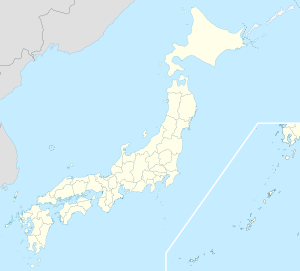Hagi (Yamaguchi)
| Hagi-shi 萩 市 |
||
|---|---|---|
| Geographical location in Japan | ||
|
|
||
| Region : | Chūgoku | |
| Prefecture : | Yamaguchi | |
| Coordinates : | 34 ° 24 ' N , 131 ° 24' E | |
| Basic data | ||
| Surface: | 698.86 km² | |
| Residents : | 45,435 (October 1, 2019) |
|
| Population density : | 65 inhabitants per km² | |
| Community key : | 35204-7 | |
| Symbols | ||
| Flag / coat of arms: | ||
| Tree : | Hinoki cypress , pine | |
| Flower : |
Camellia , bush clover ("Hagi") |
|
| Fruit : | Citrus natsudaidai | |
| town hall | ||
| Address : |
Hagi City Hall 510 Ōaza Emukai Hagi -shi Yamaguchi 758-8555 |
|
| Website URL: | http://www.city.hagi.lg.jp/ | |
| Location Hagis in Yamaguchi Prefecture | ||
Hagi ( Japanese 萩 市 , - shi ) is a city in Yamaguchi Prefecture in Japan .
history
Hagi is an important old castle town , formerly ruled by the Mōri , with Hagi Castle , from which many famous men (see below) come who participated in the Meiji restoration and then worked in Tokyo. Hagi has been known for the Hagi pottery produced there since the beginning of the Edo period . After 1868, with the return of the fief to the Tennō ( 版 籍 奉還 , hanseki hōkan ), the place lost its importance, but on July 1, 1932, it was raised to an independent city (shi) .
Due to the rapid shift in the political focus, Hagi (along with Kanazawa , Kadonodate ) is one of those places where much has been preserved that can convey the flair of a place from the samurai era. Of the castle itself, however, only part of the outer bailey has been preserved.
Worth seeing are the Hagi local museum in the form of a samurai residence and the Kumaya art museum of the Kumaya, who were economic advisers to the Mōri for many generations. In addition to valuable picture scrolls, there are also objects that Siebold gave to his friend Kumaya, including his square piano . Also worth seeing is the large tomb in the forest near the Tokoji Temple, where some of the princes and members of the Mōri clan are buried.
geography
Hagi is west of Osaka , north of Yamaguchi and east of Nagato on the Sea of Japan .
traffic
- Street:
- National Road 191, to Hiroshima or Shimonoseki
- National Road 262, to Hofu
- National Road 315, to Shūnan
- National road 490, to Ube
- Train:
- JR West San'in Main Line to Kyoto or Shimonoseki
International partnerships
-
 Ulsan , the oldest Japanese-Korean city partnership since October 29, 1968
Ulsan , the oldest Japanese-Korean city partnership since October 29, 1968 -
 (Ward) Deokjin- myeon , (county) Yeongam - gun , Jeollanam-do
(Ward) Deokjin- myeon , (county) Yeongam - gun , Jeollanam-do
-
 In 1992 the village of Asahi (now Akiragi-chiku and Sasanami-chiku), which was incorporated into Hagi on March 6, 2005, entered into a partnership with Ühlingen-Birkendorf .
In 1992 the village of Asahi (now Akiragi-chiku and Sasanami-chiku), which was incorporated into Hagi on March 6, 2005, entered into a partnership with Ühlingen-Birkendorf .
Neighboring cities and communities
sons and daughters of the town
- Noriko Anno (* 1976), judoka
- Aoki Shūzō (1844–1914), Ambassador to Berlin, Foreign Minister
- Hokkai Takashima (1850–1931), painter and botanist
- Inoue Kenkabō (1870-1934), writer
- Itō Hirobumi (1841–1909), politician and prime minister
- Katsura Tarō (1848–1913), officer, politician and prime minister
- Kido Takayoshi (1833–1877), politician of the Meiji Restoration
- Miwa Kyūwa (1895–1981), potter
- Miura Gorō (1847–1926), Lieutenant General and Consul in the Korean Empire
- Nosaka Sanzō (1892-1993), politician and co-founder of the Communist Party of Japan
- Shiga Yoshio (1901–1989), Marxist politician
- Takasugi Shinsaku (1839–1867), military leader of the Meiji Restoration
- Takeo Kawamura (* 1942), politician
- Tanaka Giichi (1863–1929), general, politician and prime minister
- Yamagata Aritomo (1838–1922), military leader, politician, national hero and prime minister
- Yoshida Shōin (1830-1859), intellectual, teacher and revolutionary
literature
- N. Taylor Gregg and Sam Abell (Photographs): Hagi: Where Japan's Revolution Began . In: National Geographic . Vol. 165, June 1984, pp. 750-773 ( online ).
Individual evidence
- ^ On a list of Japanese-German parish partnerships published by the Japanese Embassy , Ühlingen-Birkendorf is listed together with Hagi; on the partner municipality list Ühlingen-Birkendorf ( memento from September 1, 2015 in the Internet Archive ), however, “Asahi” is found instead of “Hagi”.



